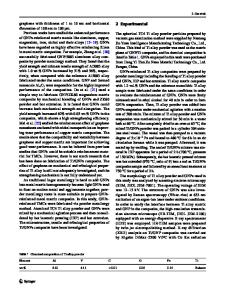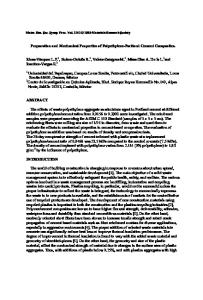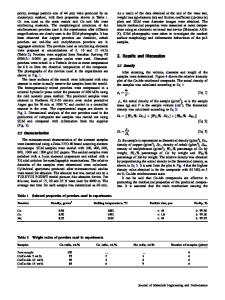Preparation and Mechanical Properties of Particulate-Reinforced Powder Metallurgy Titanium Matrix Composites
- PDF / 536,764 Bytes
- 7 Pages / 593.972 x 792 pts Page_size
- 3 Downloads / 304 Views
INTRODUCTION
TITANIUM matrix composites (TMCs) can be divided into two types: continuously reinforced[1–3] and discontinuously reinforced.[4–7] Continuous fiber-reinforced TMCs are expensive due to high fiber costs and limited formability, and their properties are highly anisotropic. Thus, these materials have been restricted to very specialized applications. Discontinuous or particulate-reinforced TMCs are less expensive to fabricate and their properties are nearly isotropic. Thus, particulate-reinforced TMCs have been widely studied for structural applications.[8,9] Borides, carbides, and nitrides are commonly used for reinforcements, which play an important role in particulate-reinforced TMCs. The most promising particles are considered to be TiC and TiB due to their good thermal and chemical compatibility with the Ti matrix.[8,10,11] In fabricating particulate-reinforced TMCs, powder metallurgy (PM) method and subsequent thermomechanical treatment is effective.[12–15] The elongation-to-failure of PM particulate-reinforced TMCs is poor, although the strength is relatively high. For example, Saito[16] developed a composite of Ti-4.3Fe-7.0Mo-1.4Al-1.4V-5.4B (wt pct). The roomtemperature (RT) tensile strength is as high as B. LIU, Graduate Postdoctoral Candidate Student, Y. LIU and B.Y. HUANG, Professors, and X.Y. HE and L.F. CHEN, Master Degree Candidate Students, are with the State Key Laboratory of Powder Metallurgy, Central South University, Changsha 410083, People’s Republic of China. Contact e-mail: [email protected] H.P. TANG, Professor, is with the Northwest Institute of Non-ferrous Metal Research, Xi’an 710016, People’s Republic of China. Manuscript submitted May 1, 2007. Article published online September 27, 2007. METALLURGICAL AND MATERIALS TRANSACTIONS A
2025 MPa, while the elongation-to-failure is only 1.4 pct. For most particulate-reinforced TMCs, the elongation-to-failure is also less than 5 pct.[16,17] The high strength and low elongation-to-failure will make metal-working of TMCs more difficult, and will increase the fabrication cost. The poor elongation-to-failure of particulate-reinforced TMCs is presumably due to the interfacial debonding during plastic deformation and the brittle nature of the PM Ti alloy matrix. In-situ reaction is helpful for the formation of clean interface as well as improvement of bonding between particles and the matrix because the reinforcements are formed from the parent Ti matrix.[18,19] Therefore, compared with directly adding particles into the Ti matrix, in-situ reaction is more suitable for formation of strengthening phases. Another important method used to improve the elongation-to-failure and other mechanical properties (e.g., high-temperature strength) is the modify Ti matrix simultaneously, which has been rarely considered. Chromium has been used extensively to increase the elongation-to-failure of Ti alloys due to its effect on stabilizing the b phase, which exhibits higher elongation-to-failure than the a phase.[20] Therefore, addition of Cr is a suitable wa
Data Loading...











